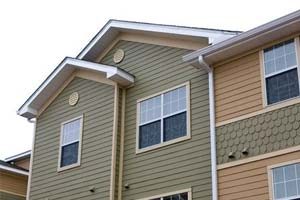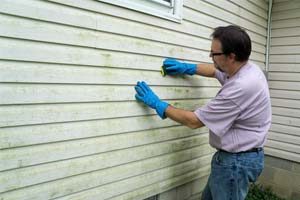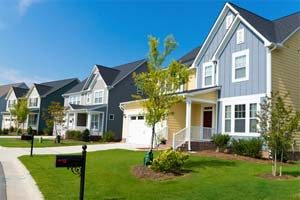The Purpose of Siding
 Siding serves two main purposes for your home: protection and aesthetics. Siding protects your home from the elements: snow, ice, water, and generally harsh weather conditions including strong winds. Additionally, siding is often the very first thing a passerby notices about your home. Professionally installed quality siding enhances the appearance of your home from all angles. The siding you choose is completely up to you: it is available in a wide variety of different colors and patterns, so you can create a fully custom home exterior that’s truly unique and speaks to you.
Siding serves two main purposes for your home: protection and aesthetics. Siding protects your home from the elements: snow, ice, water, and generally harsh weather conditions including strong winds. Additionally, siding is often the very first thing a passerby notices about your home. Professionally installed quality siding enhances the appearance of your home from all angles. The siding you choose is completely up to you: it is available in a wide variety of different colors and patterns, so you can create a fully custom home exterior that’s truly unique and speaks to you.
The Importance of Siding Maintenance
Quite often, homeowners only choose to fix their siding when it has a glaring visible issue. It saves you both time and money in the long run if you engage in regular maintenance and repairs rather than waiting to reach a crisis point. This is why the importance of siding maintenance cannot be underestimated.
It is essential to look after your siding regularly for two key reasons. First, damaged siding can indirectly cause damage to other parts of your home by letting the elements penetrate through it. Second, damaged siding ruins the look of your home, and can even impact the selling value of it. Taking these reasons into account, it’s much easier to do maintenance than to have to pay for costly repairs or reinstallation.
Failing to take care of the siding on the exterior of your home will inevitably lead to bigger problems in the future. For example, siding that is cracked or damaged will allow moisture, dirt, mold, and a host of other unwanted organic material to leach inside your home. This can be detrimental to the structural integrity of your home: both the framework and the actual interior.
5 Dangers to Your Home’s Siding
 Siding acts as a protective barrier over your entire home. It’s strong and resilient, but this doesn’t mean it’s completely impenetrable. Different environmental conditions can wreak havoc with even the most soundly installed siding. It’s a fact of life that things go through wear and tear as the years go by.
Siding acts as a protective barrier over your entire home. It’s strong and resilient, but this doesn’t mean it’s completely impenetrable. Different environmental conditions can wreak havoc with even the most soundly installed siding. It’s a fact of life that things go through wear and tear as the years go by.
Siding isn’t the only part of a home’s exterior that can be vulnerable to environmental factors. There are also dangers to your home’s roof that you should be aware of, including snow, pests, and trees. The roof and your siding work together to protect you and your family from the harsh elements, so it’s important to take care of them.
In order to help you do so, here are 5 dangers to your home’s siding that you should look out for:
Termites
Termites are a pest ― literally! These little critters will cause a home to disintegrate. Yes, they work slowly, but isn’t it creepy to think a termite is slowly eating away the roof over your head? Oh and they also love to attack your siding. Termites love anything made of wood, and did you know that they eat it up and then recycle it by turning it into soil?
The worst thing about termites is that they are all over America. You can’t decide to move to a state where there are none, because they’re pretty much everywhere. Therefore, homeowners all across the nation need to learn how to deal with them.
Thankfully, siding can be treated to be resistant to termites. This often involves painting or spraying chemicals onto the wood that will deter the termites. Some of these chemical products require one application; some require repeated ones. They’re not the most environmentally friendly substances in the world, so if you’re eco-conscious, you might want to opt for fiber cement siding. Fiber cement siding is made in such a way that the cellulose fibers are mixed with other materials, forming a siding that is naturally insect repellent.
Therefore, if you’re a homeowner with a different type of siding and have a home infested with termites, you may want to look into having your current siding replaced with fiber cement siding.
Trees
If you have trees that are very close to your home, they can ruin the siding. This is because any trees that have low-hanging branches can scratch and scrape the siding, causing it to weaken and become vulnerable to moisture over time. You can prevent this by doing regular gardening and cutting down any branches that threaten to hang too closely to your house exterior.
Sunshine
The summer months are often welcomed with a loud cheer after the winter period. However, even sunshine can impact the siding of your home. Harsh UV rays can cause your siding to fade, crack, or break. This is particularly true if your siding is made of wood.
Dust
Dust on its own isn’t a big problem, but it attracts moisture. Now, it isn’t realistic to tell you to dust your siding once a week (!), but it’s worth bearing in mind. The dust that builds up on the siding crevices can gradually cause moisture to build up in the same area, which can lead to water getting inside your home. Making sure your siding is well-maintained will ensure this is a rarity, however.
Moisture
Probably the most hazardous of all the dangers, if moisture works it way into between the imperfections in your siding, it can really damage your home. Rotting and structural damage can potentially occur if moisture leaks through cracks in your siding.
Siding Maintenance
 Homeowners can evaluate the state of their siding by conducting regular maintenance. This isn’t a complicated affair. The type of maintenance you do depends on the type of siding you have. For example, if you fiber cement siding, you need to examine the caulked areas (the trim and flashing) and keep an eye out for signs of deterioration.
Homeowners can evaluate the state of their siding by conducting regular maintenance. This isn’t a complicated affair. The type of maintenance you do depends on the type of siding you have. For example, if you fiber cement siding, you need to examine the caulked areas (the trim and flashing) and keep an eye out for signs of deterioration.
No matter what type of siding you have, you can maintain it by cleaning it once or twice a year to remove lingering dirt and debris. General maintenance also involves checking for cracks, gaps, or general disrepair. Any homeowner can do this by simply walking around their house and examining the siding thoroughly.
Siding Contractors
If, after examining your siding, you find it needs repair, you’ll need to hire a siding contractor. Depending on the extent of the damage, you can decide between whether you want to get your siding repaired or replaced. Siding is a popular choice for homeowners because of its versatility of design, reasonable price, and durability. It’s best to leave it up to the professionals to make sure repairs or installation are of a high quality finish.
So, now you know how to take care of your siding, and what to do if it needs repair. Good luck with your home improvement projects!